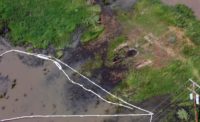Crews Battle Ice To Clean Up Yellowstone River Oil Spill

Bridger Pipeline LLC must install horizontal, directionally drilled crossings on its Poplar Pipeline where it crosses two rivers after a Jan. 17 breach spilled more than 29,000 gallons of oil into the Yellowstone River, near Glendive, Mont.
The cause of the breach has not been determined, but sonar testing on Jan. 24 showed that the 2,250-ft section of pipeline—laid in a trench and, in 2011, shown to be 8 ft underneath the river—is, at one point, actually 1 ft above the riverbed.
The breach is about 50 ft from the river's south bank, says Bill Salvin, Bridger spokesman. It is about seven miles upstream of the Glendive water system, which was shut down after volatile organic compounds, including benzene, showed up in the water. The system has been treated, and the 6,000 residents can now drink the water.
"This will be a long-term recovery," says Paul Peronard, on-scene coordinator with the U.S. Environmental Protection Agency.
One challenge is ice, which impedes discovery of oil in the water and changes the water flow into a rolling, tumbling current that mixes the oil with sediment.
Crews have cut slots in the ice and inserted sheets of plywood to divert oil to the riverbank, as they would with booms in open water, Peronard says.
Other crews, in airboats on the river, find oil, cut a hole in the ice and use hydrophobic oil-absorbing swabs to capture the oil, he says.
As temperatures rose over the Jan. 24-25 weekend, the ice started to break up, hindering work. So, Peronard predicts crews will have to come back after the spring melt, "almost like a second event." Response teams on typical oil spills are able to recover about half the oil lost, he says, but he estimates this recovery will capture only 5% to 10% of the light crude spilled.
The U.S. Pipeline and Hazardous Materials Safety Administration order issued on Jan. 23 says Bridger must install the HDD crossings at both the Yellowstone River and the Poplar River, which also has an open-cut crossing. The pipeline runs for 193 miles in eastern Montana.
The 692-mile Yellowstone, the longest undammed river in the contiguous U.S., is home to a wide variety of fish, especially in the spill area. Among them are bass, crappie, shiners and perch as well as the endangered pallid sturgeon and the paddlefish, a major source of domestic caviar. The Montana Fish, Wildlife and Parks Dept. on Jan. 21 issued a warning about eating fish caught between the spill area and the North Dakota state line.
Also on Jan. 23, the Pipeline and Hazardous Materials Safety Administration fined ExxonMobil Pipeline Co. $1.045 million after its Silvertip Pipeline spilled 63,000 gallons into the Yellowstone, near Laurel, Mont., in 2011. This is a reduction from a $1.7-million penalty announced earlier.
ExxonMobil, which has 20 days to answer, is reviewing the order, a spokesman said. Montana also fined the company $1.6 million.




